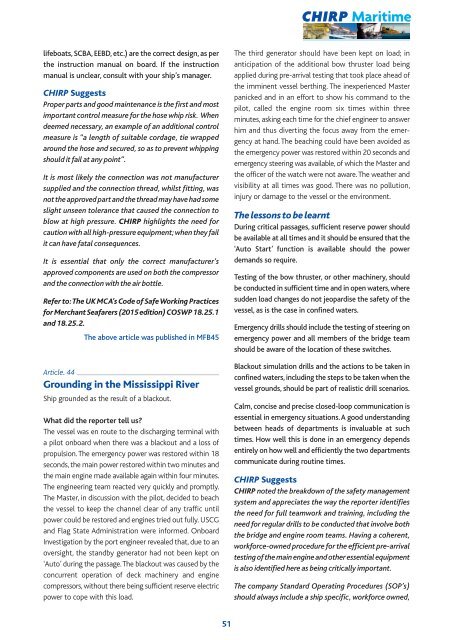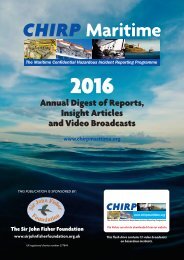CHIRP annual digest 2016 6th
Create successful ePaper yourself
Turn your PDF publications into a flip-book with our unique Google optimized e-Paper software.
<strong>CHIRP</strong> Maritime<br />
lifeboats, SCBA, EEBD, etc.) are the correct design, as per<br />
the instruction manual on board. If the instruction<br />
manual is unclear, consult with your ship’s manager.<br />
<strong>CHIRP</strong> Suggests<br />
Proper parts and good maintenance is the first and most<br />
important control measure for the hose whip risk. When<br />
deemed necessary, an example of an additional control<br />
measure is “a length of suitable cordage, tie wrapped<br />
around the hose and secured, so as to prevent whipping<br />
should it fail at any point”.<br />
It is most likely the connection was not manufacturer<br />
supplied and the connection thread, whilst fitting, was<br />
not the approved part and the thread may have had some<br />
slight unseen tolerance that caused the connection to<br />
blow at high pressure. <strong>CHIRP</strong> highlights the need for<br />
caution with all high-pressure equipment; when they fail<br />
it can have fatal consequences.<br />
It is essential that only the correct manufacturer’s<br />
approved components are used on both the compressor<br />
and the connection with the air bottle.<br />
Refer to: The UK MCA’s Code of Safe Working Practices<br />
for Merchant Seafarers (2015 edition) COSWP 18.25.1<br />
and 18.25.2.<br />
The above article was published in MFB45<br />
Article. 44<br />
Grounding in the Mississippi River<br />
Ship grounded as the result of a blackout.<br />
What did the reporter tell us?<br />
The vessel was en route to the discharging terminal with<br />
a pilot onboard when there was a blackout and a loss of<br />
propulsion. The emergency power was restored within 18<br />
seconds, the main power restored within two minutes and<br />
the main engine made available again within four minutes.<br />
The engineering team reacted very quickly and promptly.<br />
The Master, in discussion with the pilot, decided to beach<br />
the vessel to keep the channel clear of any traffic until<br />
power could be restored and engines tried out fully. USCG<br />
and Flag State Administration were informed. Onboard<br />
Investigation by the port engineer revealed that, due to an<br />
oversight, the standby generator had not been kept on<br />
‘Auto’ during the passage. The blackout was caused by the<br />
concurrent operation of deck machinery and engine<br />
compressors, without there being sufficient reserve electric<br />
power to cope with this load.<br />
The third generator should have been kept on load; in<br />
anticipation of the additional bow thruster load being<br />
applied during pre-arrival testing that took place ahead of<br />
the imminent vessel berthing. The inexperienced Master<br />
panicked and in an effort to show his command to the<br />
pilot, called the engine room six times within three<br />
minutes, asking each time for the chief engineer to answer<br />
him and thus diverting the focus away from the emer -<br />
gency at hand. The beaching could have been avoided as<br />
the emergency power was restored within 20 seconds and<br />
emergency steering was available, of which the Master and<br />
the officer of the watch were not aware. The weather and<br />
visibility at all times was good. There was no pollution,<br />
injury or damage to the vessel or the environment.<br />
The lessons to be learnt<br />
During critical passages, sufficient reserve power should<br />
be available at all times and it should be ensured that the<br />
‘Auto Start’ function is available should the power<br />
demands so require.<br />
Testing of the bow thruster, or other machinery, should<br />
be conducted in sufficient time and in open waters, where<br />
sudden load changes do not jeopardise the safety of the<br />
vessel, as is the case in confined waters.<br />
Emergency drills should include the testing of steering on<br />
emergency power and all members of the bridge team<br />
should be aware of the location of these switches.<br />
Blackout simulation drills and the actions to be taken in<br />
confined waters, including the steps to be taken when the<br />
vessel grounds, should be part of realistic drill scenarios.<br />
Calm, concise and precise closed-loop communication is<br />
essential in emergency situations. A good under standing<br />
between heads of departments is invaluable at such<br />
times. How well this is done in an emergency depends<br />
entirely on how well and efficiently the two departments<br />
communicate during routine times.<br />
<strong>CHIRP</strong> Suggests<br />
<strong>CHIRP</strong> noted the breakdown of the safety management<br />
system and appreciates the way the reporter identifies<br />
the need for full teamwork and training, including the<br />
need for regular drills to be conducted that involve both<br />
the bridge and engine room teams. Having a coherent,<br />
workforce-owned procedure for the efficient pre-arrival<br />
testing of the main engine and other essential equipment<br />
is also identified here as being critically important.<br />
The company Standard Operating Procedures (SOP’s)<br />
should always include a ship specific, workforce owned,<br />
51



